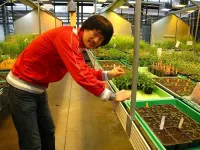Two plant immune branches more intimately connected than previously believed
2021-04-01
(Press-News.org) Plant inducible defense starts with the recognition of microbes, which leads to the activation of a complex set of cellular responses. There are many ways to recognize a microbe, and recognition of microbial features by pattern recognition receptors (PRRs) outside the cell was long thought to activate the first line of defense: Pattern Triggered Immunity, or PTI. To avoid these defense responses, microbes of all kinds evolved the ability to deliver effector molecules to the plant cell, either directly into the cytoplasm or into the area just outside the cell, where they are taken up into the cytoplasm. Response to these effector molecules was thought to be mediated exclusively by intracellular nucleotide-binding domain leucine-rich repeat receptors (NLRs) which induce Effector Triggered Immunity, or ETI. These two signaling pathways are often thought of as two distinct branches of the plant immune response, with each contributing differently to overall immunity. However, the dichotomy between PTI and ETI has become blurred due to recent discoveries, indicating that responses to PRR receptor signaling and NLR signaling extensively overlap.
"The two immune branches were previously considered to be separate but increasing evidence in recent years shows that they are intimately connected," explained Kenichi Tsuda, a plant biologist at Huazhong Agricultural University in China. "It is time to re-think the current model."
Over the past year and a half, exciting findings have revealed a much more complex and nuanced picture of plant defense. Tsuda and colleague You Lu, of the University of Minnesota in the United States, collaborated on a review recently published in the MPMI journal. Their goal was to integrate these new ideas with the long-standing model of separate ETI and PTI pathways into a newer, more nuanced model in which the pathways do exist, but with multiple points of interaction between them and in which each pathway is intimately connected.
These ideas are central to our understanding of the interactions between plants and microbes, but also have important implications for agriculture. "These two branches of plant immunity contribute majorly to pathogen resistance," said Tsuda. "Modes of action of the plant immune system is fundamental to any application of our knowledge into practice such as agriculture."
Despite the huge effort from the research community to understand plant defense signaling and the many recent advances, there are still many unknowns in this area. For example, Tsuda says the mechanism of "how NLRs use PRRs is completely unknown." In fact, Lu and Tsuda propose two models that might explain this interaction at a cellular level, one of which involves signaling between cells in a tissue, leading to Tsuda's recommendation for researchers to examine immune responses at the single cell level.
"As many researchers are tackling this question, we will need to update our model on a yearly basis," Tsuda concluded.
INFORMATION:
Read more in "Intimate Association of PRR- and NLR-Mediated Signaling in Plant Immunity." This study was made available online in December 2020 ahead of final publication in issue in January 2021. This article is part of the Top 10 Unanswered Questions invited review series in MPMI. See the list of the top 10 unanswered questions here. You can also watch Dr. Kenichi Tsuda present on this review article in his free virtual seminar.
[Attachments] See images for this press release:

ELSE PRESS RELEASES FROM THIS DATE:
2021-04-01
New research published today in the journal Blood Advances is the first to show that restricting calories, reducing fat and sugar intake, and increasing physical activity may boost the effectiveness of chemotherapy for older children and adolescents with leukemia. This intervention, which improved chemotherapy outcomes for children being treated at two institutions, will be further studied through a national trial later this year.
B-cell acute lymphoblastic leukemia (B-ALL), a cancer affecting the white blood cells in the bone marrow, is the most common type of cancer in children. In the study, researchers assessed the effects of diet and exercise on 40 individuals aged 10-21 undergoing chemotherapy at ...
2021-04-01
In some cancers, including leukemia in children and adolescents, obesity can negatively affect survival outcomes. Obese young people with leukemia are 50% more likely to relapse after treatment than their lean counterparts.
Now, a study led by researchers at UCLA and Children's Hospital Los Angeles has shown that a combination of modest dietary changes and exercise can dramatically improve survival outcomes for those with acute lymphoblastic leukemia, the most common childhood cancer.
The researchers found that patients who reduced their calorie intake by 10% or more and adopted a moderate exercise program immediately after their diagnosis had, on average, 70% less ...
2021-04-01
For years, research to pin down the underlying cause of Alzheimer's Disease has been focused on plaque found to be building up in the brain in AD patients. But treatments targeted at breaking down that buildup have been ineffective in restoring cognitive function, suggesting that the buildup may be a side effect of AD and not the cause itself.
A new study led by a team of Brigham Young University researchers finds novel cellular-level support for an alternate theory that is growing in strength: Alzheimer's could actually be a result of metabolic dysfunction in the brain. In other words, there is growing evidence that diet and lifestyle are at the ...
2021-04-01
Los Angeles (April 1, 2021) -- Overweight children and adolescents receiving chemotherapy for treatment of leukemia are less successful battling the disease compared to their lean peers. Now, research conducted at the END ...
2021-04-01
Buildings are responsible for 40 percent of primary energy consumption and 36 percent of total CO2 emissions. And, as we know, CO2 emissions trigger global warming, sea level rise, and profound changes in ocean ecosystems. Substituting the inefficient glazing areas of buildings with energy efficient smart glazing windows has great potential to decrease energy consumption for lighting and temperature control.
Harmut Hillmer et al. of the University of Kassel in Germany demonstrate that potential in "MOEMS micromirror arrays in smart windows for daylight steering," a paper published recently in the inaugural issue of the Journal of Optical Microsystems.
"Our smart glazing ...
2021-04-01
A highly contagious SARS-CoV-2 variant was unknowingly spreading for months in the United States by October 2020, according to a new study from researchers with The University of Texas at Austin COVID-19 Modeling Consortium. Scientists first discovered it in early December in the United Kingdom, where the highly contagious and more lethal variant is thought to have originated. The journal Emerging Infectious Diseases, which has published an early-release version of the study, provides evidence that the coronavirus variant B117 (501Y) had spread across the globe undetected for months when scientists discovered it.
"By the time we learned about the U.K. variant ...
2021-04-01
A possible explanation for why many cancer drugs that kill tumor cells in mouse models won't work in human trials has been found by researchers with The University of Texas Health Science Center at Houston (UTHealth) School of Biomedical Informatics and McGovern Medical School.
The research was published today in Nature Communications.
In the study, investigators reported the extensive presence of mouse viruses in patient-derived xenografts (PDX). PDX models are developed by implanting human tumor tissues in immune-deficient mice, and are commonly ...
2021-04-01
Boulder, Colo., USA: The Geological Society of America regularly publishes
articles online ahead of print. For March, GSA Bulletin topics
include multiple articles about the dynamics of China and Tibet; the ups
and downs of the Missouri River; the Los Rastros Formation, Argentina; the
Olympic Mountains of Washington State; methane seep deposits; meandering
rivers; and the northwest Hawaiian Ridge. You can find these articles at
https://bulletin.geoscienceworld.org/content/early/recent
.
Transition from a passive to active continental ...
2021-04-01
We've all heard the adage, "If at first you don't succeed, try, try again," but new research from Carnegie Mellon University and the University of Pittsburgh finds that it isn't all about repetition. Rather, internal states like engagement can also have an impact on learning.
The collaborative research, published in Nature Neuroscience, examined how changes in internal states, such as arousal, attention, motivation, and engagement can affect the learning process using brain-computer interface (BCI) technology. Findings suggest that changes in internal states can systematically influence how behavior improves with learning, thus paving the way ...
2021-04-01
A study reported in the journal Current Biology on April 1 has both good news and bad news for the future of African elephants. While about 18 million square kilometers of Africa--an area bigger than the whole of Russia--still has suitable habitat for elephants, the actual range of African elephants has shrunk to just 17%of what it could be due to human pressure and the killing of elephants for ivory.
"We looked at every square kilometer of the continent," says lead author Jake Wall of the Mara Elephant Project in Kenya. "We found that 62% of those 29.2 million ...
LAST 30 PRESS RELEASES:
[Press-News.org] Two plant immune branches more intimately connected than previously believed



